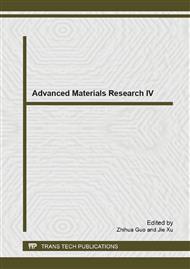[1]
Brooks, C.R., Principles of the Austenitization of Steels. 1992: Elsevier Science Publishers LTD.
Google Scholar
[2]
Flemings, M.C., Solidification processing. 1974: McGraw-Hill.
Google Scholar
[3]
Grossterlinden, R., et al., Formation of pearlitic banded structures in ferritic-pearlitic steels. Steel research, 1992. 63(8): pp.331-336.
DOI: 10.1002/srin.199200529
Google Scholar
[4]
Thompson, S.W. and P.R. Howell, Factors influencing ferrite/pearlite banding and origin of large pearlite nodules in a hypoeutectoid plate steel. Materials Science and Technology, 1992. 8(9): pp.777-784.
DOI: 10.1179/mst.1992.8.9.777
Google Scholar
[5]
Offerman, S.E., et al., Ferrite/pearlite band formation in hot rolled medium carbon steel. Materials Science and Technology, 2002. 18(3): pp.297-303.
DOI: 10.1179/026708301225000752
Google Scholar
[6]
Verhoeven, J.D., A review of microsegregation induced banding phenomena in steels. Journal of materials engineering and performance, 2000. 9(3): pp.286-296.
DOI: 10.1361/105994900770345935
Google Scholar
[7]
Totten, G.E., L. Xie, and K. Funatani, Handbook of Mechanical Alloy Design. 2003: Taylor & Francis.
Google Scholar
[8]
Harvey, P.D. and A.S. f. Metals, Engineering properties of steel. 1982: American Society for Metals.
Google Scholar
[9]
Key-to-Metals-Database, Steel Properties. 2013, Key-to-Metals AG: Zurich.
Google Scholar
[10]
Peng, X.N., et al., Analysis of Microstructure and Micro Mechanical Properties for Weld Joints of 1000MPa Class Steel by Nanoindentation Technique. Applied Mechanics and Materials, 2012. 217: p.1987-(1993).
DOI: 10.4028/www.scientific.net/amm.217-219.1987
Google Scholar
[11]
Choi, Y., W. Yong Choo, and D. Kwon, Analysis of mechanical property distribution in multiphase ultra-fine-grained steels by nanoindentation. Scripta materialia, 2001. 45(12): pp.1401-1406.
DOI: 10.1016/s1359-6462(01)01176-9
Google Scholar
[12]
Szwaja, N., Elastic and Elasto-Plastic Finite Element Analysis of a Tension Test Specimen With and Without Voids. 2012, Rensselaer Polytechnic Institute.
Google Scholar
[13]
Ling, Y., Uniaxial true stress-strain after necking. AMP Journal of Technology, 1996. 5: pp.37-48.
Google Scholar
[14]
NPL-Manual, Manual for the Calculation of Elastic-Plastic Materials Models Parameters. 2007, Queen's Printer: Scotland, UK.
Google Scholar


